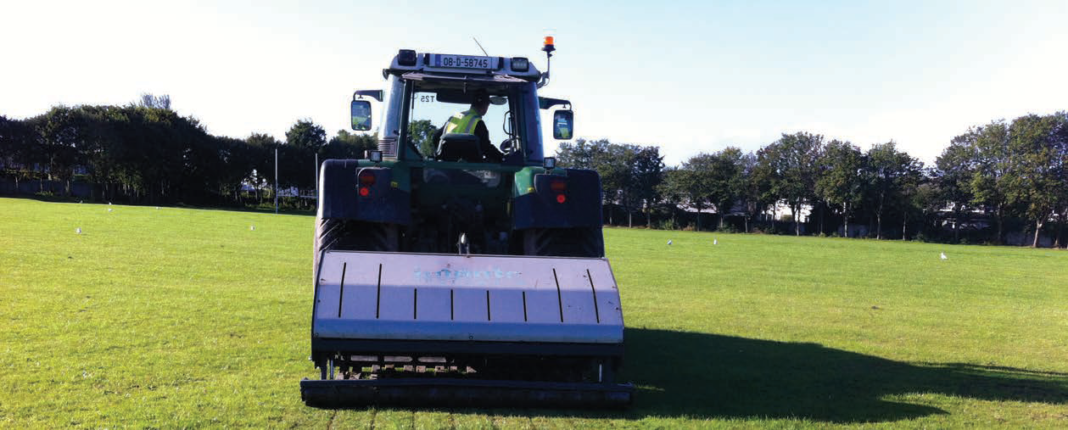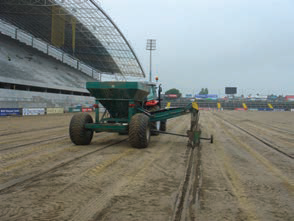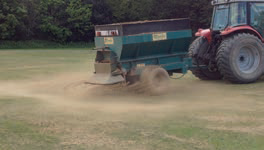Landscape construction specialist Peter O’Toole provides details on how to maximise budget spend when calculating for the maintenance of natural grass surfaces
The maintenance of sports turf ranges in scale from the preparation required for having Croke Park surface ready on All Ireland Final Day to having the school open space ready for sports day (and everything in between). The position of any surface along this scale depends mainly on budgets.
The priority of the grounds staff in stadiums such as Croke Park and Aviva is primarily to have them looking good for the cameras and spectators with the obvious hope that they can remain so for the duration of the game being played. Generous budgets will provide for the expert advice, equipment and material required to achieve this. These pitches also have the luxury or benefit of not having to suffer from over-use and are allowed time to recover. However, most sports surfaces are managed from a very different perspective with limiting constraints and it is these types which we will be discussing. The recommendations will not be specific to any type of sport but will cover the general maintenance principles for most sports.
The key elements in the successful maintenance of any natural grass sports turf are based on plant and soil science but are very basic horticultural principles. Apologies for stating the obvious but the most important task in sports turf maintenance is cutting the grass regularly. I’m amazed at how often I’ve seen school pitches left grow long over the summer months, not because of an absent groundsman, but intentionally, in an attempt to encourage the grass sward to thicken up. Grass responds to cutting by growing horizontally and thickening up (tillering) and so the more frequent the cutting, the thicker the sward. That said, cutting grass is the most labour intensive element of a maintenance regime and with twice-weekly cutting desirable at the height of the growing season for quality surfaces, this is often di¢cult to achieve.
The pressure of over-use of a pitch (especially during wet conditions) has an enormous effect on its ability to regenerate and grow. This is becoming more of an issue with the ever increasing demand on local authority as well as college and club pitches and has forced the move towards synthetic surfaces. An established surface has the ability to regenerate better than a relatively new one because, through the strength of its root system, it maintains the root zone in a stable condition and the grass intact, ready for regrowth. For this reason, it is always worth working and improving an established surface rather than cultivating, grading and starting a new one when possible as it takes a considerable time to achieve the balance of stability, structure and available nutrients in the soil that has been broken down. That’s why it is generally advisable that any new grass surface is allowed at least one full growing season before it is subjected to sports activities.
“Grass responds to cutting by growing horizontally and thickening up (tillering) and so the more frequent the cutting, the thicker the sward”
As the objective of sports pitch maintenance is to have the surfaces in as good a condition as possible and to cope with the demand, let’s look at the other components that need to be addressed (where budgets will allow):
AERATION
After grass cutting, aeration would be considered to be the next most important maintenance operation. Carried out in various ways, aeration serves to break up surface compaction (preventing water logging) as well as getting air, water and nutrients down to the roots and encouraging the roots to establish at a deeper level in the soil. The method we have preferred over the years is using the ‘Shockwave’ or ‘Roto Knife’ type machine, which opens fissures through the soil through the action of blades rather than the more conventional spiking type machines, which can often just create sealed holes in heavy soils with smeared walls. Even where there isn’t the budget to cover full pitch surfaces, it is still worth carrying this operation out in localised areas of excessive wear such as down the centre of the pitch and goal mouths.
The benefits of being able to aerate a pitch more than once annually are quite substantial.
SANDING
To get the full benefit from aeration, it is desirable to follow that operation with an application and brushing-in of sand. This prevents the closing of the gaps created by the aeration operation and maintains air, water and nutrient flow down to the roots. The sand used is Wexford or Silica type sand and is spread evenly at a rate of approximately 100 tons per GAA pitch and 70 tons for soccer/rugby pitches. Notwithstanding budgets, the more often this operation is carried out the better the pitch will perform. Over time this will significantly transform the structure of a soil based pitch to a sandy or sandy loam type.
FERTILISER
This is an area where a lot of research has been done over recent years and the advice is to have a soil test done on the pitch at the start of the season to establish what nutrients, if any, are required. Sometimes essential nutrients are present in the soil but are not available to the plants and the recommendation might be for an application of soil conditioner rather than a conventional fertiliser.
DRAINAGE
The benefits of a drainage system for a pitch are generally accepted and justified for new pitch construction. However, retrospectively installing drainage to old pitches isn’t always financially possible. The full complement of drains to a pitch is sand slits at 1-2m centres carrying surplus water from the surface into lateral drains running at 90 degrees to the slits and at approximately 7m centres. The lateral drains are connected to the main drain running along the side of the pitch. A properly drained surface prevents surplus water lying on the surface and causing the structure to break down and compaction to occur.
The success of a drainage system will depend on keeping the surface to the drains as open as possible and this is addressed by aeration.
WEED CONTROL
If a pitch is maintained in a healthy state and other maintenance operations as listed above are carried out, the tendency for weed infestation is low.
OVER-SEEDING
This is generally unavoidable especially when there is excessive wear on the pitch and if not carried out, it tends to lead to weed infestation in the voids. A disc-type seeder is preferable, sowing at about 15gm/m2 with a hard wearing ryegrass mix. ✽
| GENERAL BUDGET COSTS FOR PITCH MAINTENANCE (7,000M2)
✽ Soil testing: € 130 |
 PETER O’TOOLE Dip. Hort. (Kew) is the President of the Association of Landscape Contractors of Ireland, a director of Peter O’Brien and Sons (Landscaping) Ltd and a leading commentator on Ireland’s landscape contracting sector. He can be contacted at 01-845 2555 and peter@obrienlandscaping.com |







